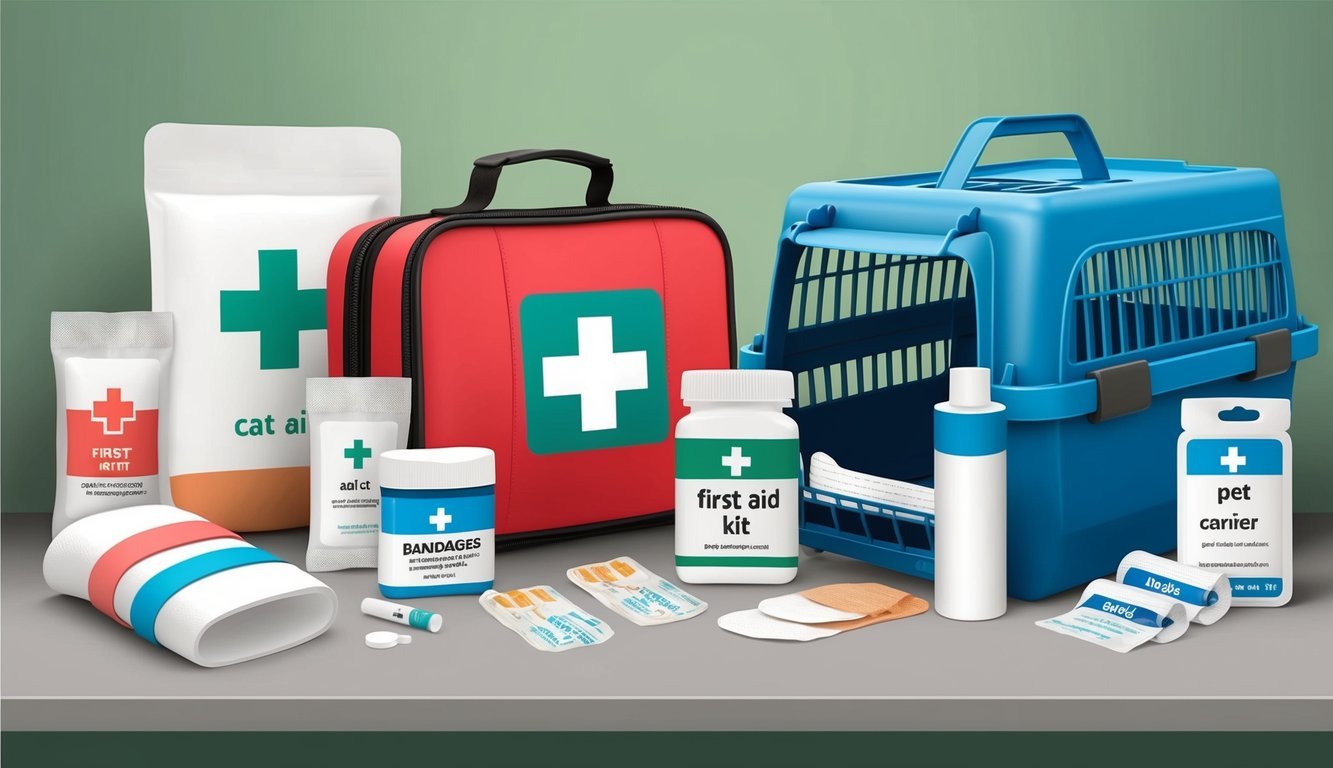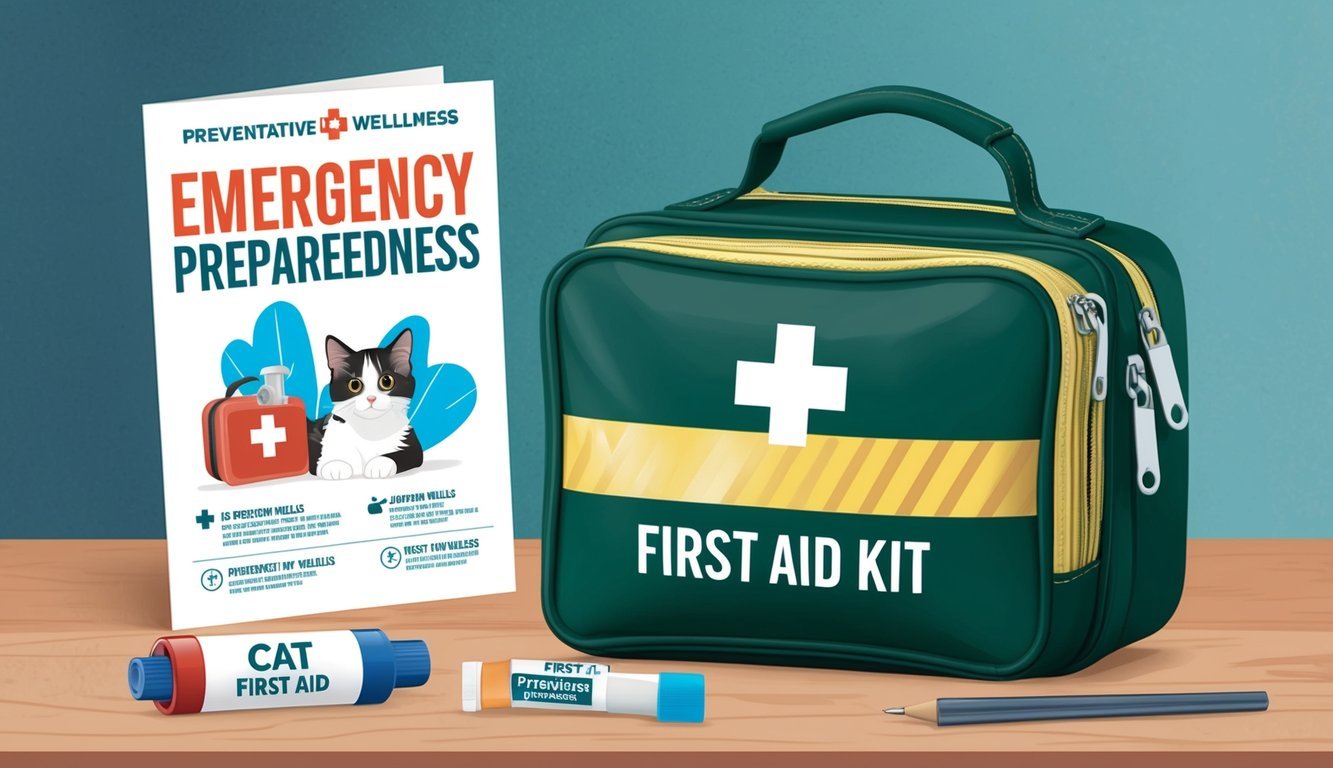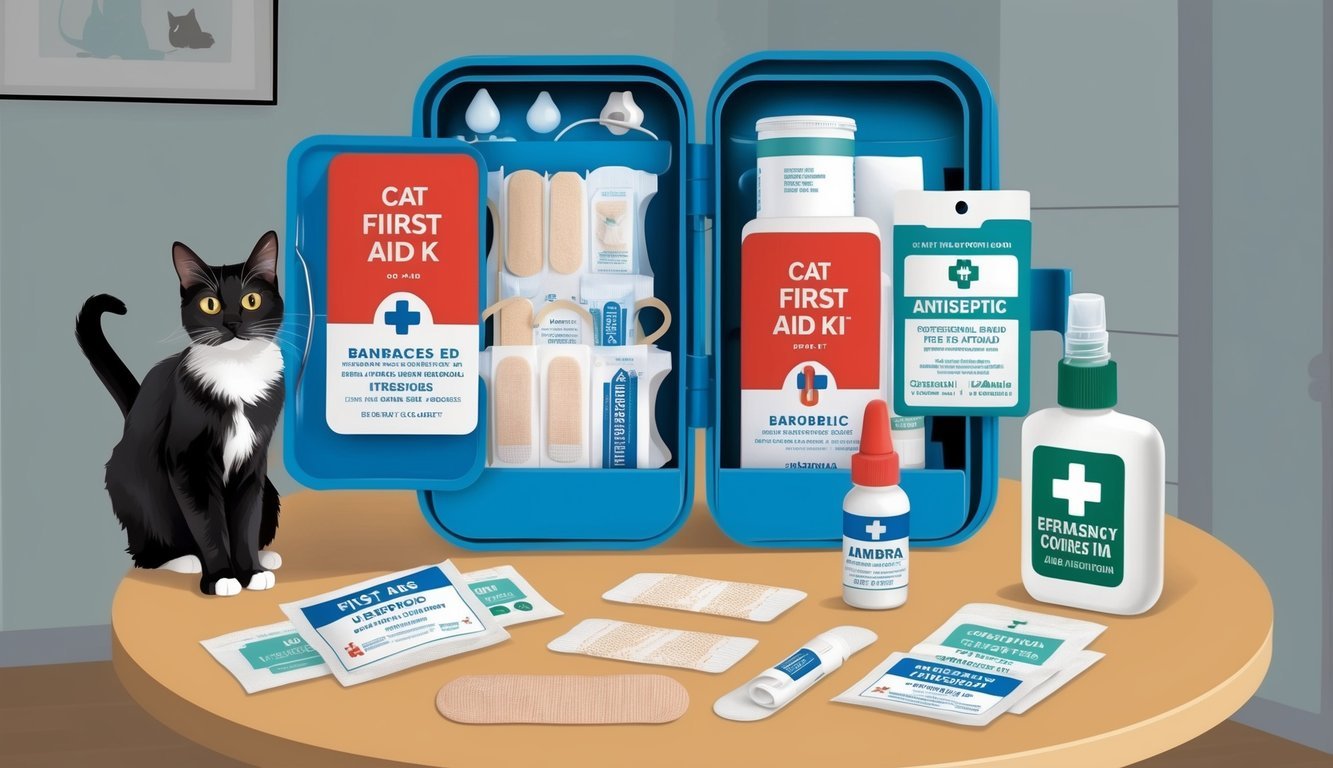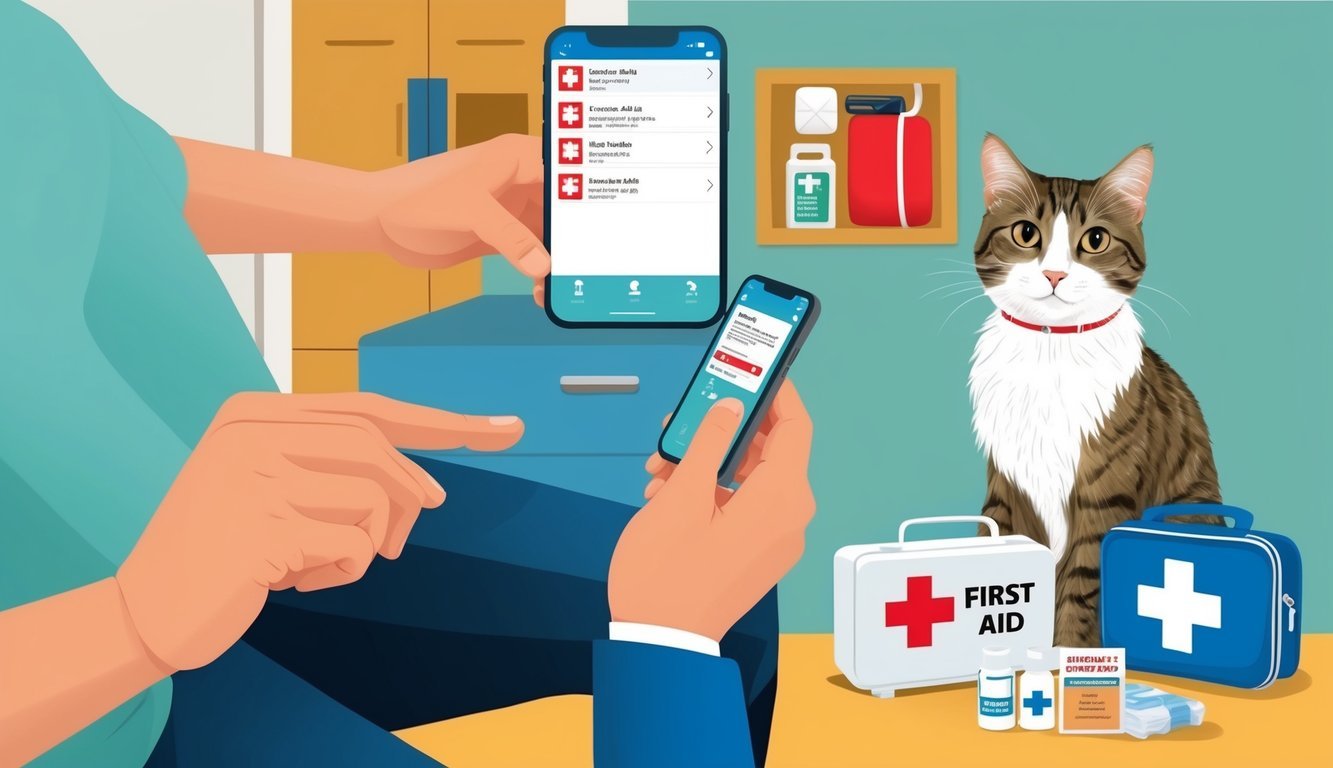When it comes to your furry friends, being prepared for emergencies is crucial.
Having a solid plan for cat first aid can make all the difference in a critical situation. Learning about pet first aid and emergency preparedness allows you to respond quickly and effectively when your cat needs help most.
Imagine facing a sudden health crisis with your cat and not knowing what to do.
It can be overwhelming, but having the right knowledge and supplies on hand can help you stay calm and focused.
From understanding basic first aid techniques to creating an emergency kit tailored for your feline companion, you’ll be better equipped to handle any situation that might arise.
This blog post will guide you through essential steps to prepare for emergencies involving your cat.
You’ll discover valuable tips on assembling a pet first aid kit, recognizing signs of distress, and ensuring your cat’s safety during unforeseen circumstances.
Get ready to empower yourself with the knowledge you need to keep your beloved pet healthy and secure.
Understanding Cat First Aid
Being prepared for emergencies involving your cat is essential.
Familiarizing yourself with the fundamentals of pet first aid, recognizing common cat emergencies, and knowing the immediate actions to take can significantly improve your cat’s chances of recovery.
Fundamentals of Pet First Aid
First aid for cats involves understanding the basic skills required to handle emergencies.
This includes having a well-stocked first aid kit specifically designed for cats.
Key items in your first aid kit might include:
- Cotton pads and swabs
- Non-stick bandage tape
- Scissors for cutting bandages
- A digital thermometer
Getting to know your cat’s vital signs—such as heart rate and breathing—is crucial.
A typical cat’s heart rate ranges from 140 to 220 beats per minute.
Monitoring these signs helps you assess your cat’s condition in emergencies.
Recognizing Cat Emergencies
Knowing how to identify emergencies is vital for prompt action.
Look out for signs such as:
- Difficulty breathing
- Excessive bleeding
- Sudden behavior changes
Some common situations that require immediate attention include poisoning, trauma from falls, or heatstroke.
Familiarizing yourself with these conditions allows you to act quickly and appropriately, potentially saving your cat’s life.
Immediate Actions During an Emergency
When faced with an emergency, your first steps can make all the difference.
Ensure your cat is safe and secure before attempting any first aid.
- Keep Calm: Your cat can sense your stress. Stay as calm as possible to avoid further panic.
- Assess the Situation: Check for visible wounds or abnormalities. Note your cat’s vital signs.
- Contact a Vet: Always inform your veterinary clinic about the situation for tailored advice.
In some cases, it may be necessary to transport your cat to an emergency veterinary facility.
Always move cautiously, supporting injured limbs if needed.
Making these moves with care can help prevent further injury.
Preparing Your Home for Emergencies

It’s essential to get your home ready for emergencies to keep your cat safe.
This involves gathering important supplies and creating a secure environment where your feline friend can feel safe during stressful situations.
Emergency Supplies Checklist
Having the right supplies can make all the difference.
Start with a pet disaster kit that includes:
- Food: At least a two-week supply of your cat’s regular food.
- Water: A minimum two-week stock of drinking water.
- Bowls: Non-spill food and water dishes for easy access.
- Manual Can Opener: If your cat eats canned food, ensure you have a manual can opener handy.
- Medications: Keep a two-week supply of any needed medications.
- First Aid Kit: A comprehensive kit tailored for your cat’s needs, including activated charcoal for emergencies.
Ensure you check your supplies regularly to avoid expired items.
Setting Up a Safe Environment
Creating a safe haven for your cat during emergencies is critical.
Consider designating a quiet room where your cat can feel secure.
Keep the following in mind:
- Pet Carrier: Have a sturdy and comfortable pet carrier available for easy transport.
- Hide Hazardous Items: Ensure cleaning supplies or anything toxic is stored safely out of reach.
- Secure Windows and Doors: Make sure they can’t be opened accidentally, especially during storms.
You want your cat to feel calm, so use familiar items, such as blankets or toys, in their safe area.
Creating a Pet First Aid Kit
Having a well-stocked pet first aid kit is essential for managing emergencies effectively.
Preparing this kit with the right items will enable you to respond quickly to your cat’s needs.
Essential Items for Your Kit
Start by gathering the fundamental supplies for your pet first aid kit.
Here’s a list of essential items you should include:
-
Basic First Aid Supplies:
- Sterile gauze pads in various sizes
- Adhesive tape and nonstick bandages
- Antiseptic wipes and ointment
-
Medications:
- A copy of your cat’s essential medications
- Dosage instructions
-
Monitoring Tools:
- A digital thermometer for checking your pet’s temperature
- A pair of scissors for cutting bandages or clothing
-
Emergency Contacts:
- Your veterinarian’s phone number
- The nearest animal emergency hospital details
Maintaining and Restocking Items
It’s crucial to regularly check your first aid kit to ensure all supplies are available and in good condition.
Start a routine check every few months.
-
Inspect Supplies:
- Look for expired medications or damaged items.
- Replace any used supplies immediately.
-
Update Information:
- Keep emergency contact information current.
- Change medications as your cat’s health needs evolve.
Organizing your kit can also make it easier to find what you need quickly.
Use a sturdy, waterproof container.
Label sections clearly for easy access during an emergency.
Keeping your pet first aid kit updated not only gives you peace of mind but also prepares you for unexpected situations.
Handling Common Cat Injuries and Ailments
When your cat faces an injury or health crisis, knowing how to respond quickly can make a significant difference.
Here are some critical steps for managing wounds, choking, and seizures effectively.
Addressing Wounds and Bleeding
If your cat has a wound, your first step is to assess the severity. Wash your hands and put on disposable gloves to prevent infection.
Gently clean the area with mild soap and water, but avoid hydrogen peroxide unless advised by a vet.
Apply a sterile bandage or gauze to stop bleeding.
If the bleeding persists, apply direct pressure with a clean cloth for about 5 to 10 minutes.
Monitor for signs of infection, such as swelling or discharge.
Always contact your vet if the wound looks deep or doesn’t improve.
Familiarize yourself with the signs of common cat injuries through resources like Cat First Aid Guide.
Managing Choking and Breathing Issues
In the event of choking, stay calm and check if your cat can still breathe, cough, or make noises.
If your cat is unable to breathe, you may need to perform a few quick checks.
Gently open their mouth to see if you can spot the foreign object.
If you see it and can safely grab it, do so.
If it’s not visible, try the Heimlich maneuver.
Hold your cat with their back against you and place a fist under their ribcage, giving a quick, upward thrust.
If breathing issues arise without choking, keep your cat calm and contact your vet immediately.
Dealing With Seizures and Cardiac Emergencies
When your cat has a seizure, it’s essential to ensure their safety.
Move any nearby objects that might harm them and provide a quiet, dim space.
Time the seizure if possible; if it lasts more than five minutes or they have multiple seizures in a row, you need to take them to the vet.
In case of suspected cardiac emergencies, look for signs like difficulty breathing, extreme lethargy, or fainting.
Keep your cat calm and still, and contact your vet or an emergency animal clinic right away.
Feeling prepared can make a critical difference in these situations.
CPR and Rescue Breathing for Cats
In an emergency, knowing CPR and rescue breathing for your cat can be life-saving.
Here’s what you need to do.
Recognizing a Cardiac Emergency
First, check your cat’s vital signs.
Look for:
- Breathing: Is your cat breathing at all?
- Pulse: Can you feel a heartbeat?
- Response: Is your cat responsive to stimuli?
If your cat isn’t breathing or shows no pulse, act quickly.
Performing CPR
-
Position Your Cat: Lay your cat on its right side on a firm surface.
-
Chest Compressions:
- Place your hands on the chest, just behind the front legs.
- Push down firmly but gently.
- Aim for 30 compressions every 15 seconds.
-
Rescue Breathing:
- Tilt the head back gently and pinch the nose shut.
- Cover the cat’s mouth with yours and blow gently until you see the chest rise.
- Give two rescue breaths.
Repeat
Continue with the cycle of compressions and rescue breaths until your cat starts breathing or you reach a veterinary professional.
Important: Always feel the pulse during CPR.
If you can’t detect a heartbeat, focus on compressions and breaths.
Being prepared can make a significant difference in a critical situation.
Preventative Care and Wellness

Taking an active role in your cat’s health through preventative care is essential.
Regular veterinary visits and necessary vaccinations play a key role in ensuring your feline friend stays healthy and happy.
Routine Veterinary Care
Scheduling routine veterinary visits is crucial for your cat’s overall well-being.
Generally, cats should see a vet at least once a year for a wellness check-up.
During these visits, the vet will assess your cat’s weight, dental health, and overall condition.
Make sure to discuss any behavioral changes or health concerns.
An early diagnosis can prevent more serious health issues down the line.
Strive to find a vet that you trust and feel comfortable with.
Tip: Keep a record of your cat’s vaccinations, treatments, and any medical history.
This can help your vet make informed decisions about your cat’s care.
Vaccinations and Preventative Medications
Vaccinations are vital in protecting your cat from serious diseases.
Core vaccines should be administered as kittens and booster shots provided annually.
Key vaccinations include those for feline distemper, calicivirus, and rabies.
In addition to vaccines, discuss preventative medications with your vet.
This may include treatments for heartworm, fleas, and ticks.
Regular use of these medications helps keep your cat safe from parasites that can cause illness.
Remember: Staying current on vaccinations and medications can save you from costly emergency treatments later.
Always consult your vet for a tailored vaccination schedule suited to your cat’s lifestyle and health needs.
Emergency Plan for Pet Owners
Creating a solid emergency plan is crucial for ensuring your pet’s safety during unforeseen disasters.
This includes being prepared for immediate evacuations and knowing where to find pet-friendly accommodations.
Disaster Preparedness for Pets
To effectively prepare your cat for emergencies, start by compiling a comprehensive emergency kit.
Include essentials such as a sturdy leash, carrier, food, water, and medications.
Store these items in a waterproof container to protect against damage.
Make sure to have a copy of your pet’s medical records.
Consider including vaccination history and any special dietary needs.
Having this readily accessible can save time when seeking help or boarding facilities.
It’s also wise to identify nearby veterinarians and pet-friendly boarding options ahead of time.
Familiarize yourself with local emergency shelters that accept pets.
This foresight can make all the difference if you ever need to evacuate quickly.
Pet-Friendly Accommodations During Evacuation
When an emergency strikes, knowing where to go can significantly ease the situation for both you and your cat.
Before any potential disaster, identify local pet-friendly hotels where you can stay.
Check their specific pet policies and fees to avoid last-minute surprises.
Consider creating a backup plan with friends or family who are willing to take in your pets.
Having multiple options can provide peace of mind when making quick decisions.
Additionally, ensure that you have pet-friendly transportation lined up.
Your vehicle should be ready with necessary supplies in case you need to travel.
Prioritize your cat’s comfort and safety throughout the process, as a little preparation goes a long way during emergencies.
Resources for Further Learning

Staying informed about cat first aid can make a significant difference in emergencies.
There are various resources available that provide in-depth knowledge and training, helping you prepare for potential situations involving your furry friend.
American Red Cross and Other Institutions
The American Red Cross offers valuable training programs specifically designed for pet owners.
Their Cat and Dog First Aid Online Course teaches you essential first aid techniques to use during emergencies.
This course covers common pet emergencies, how to assess your pet’s condition, and what supplies to keep on hand.
In addition to the Red Cross, local veterinary clinics and animal welfare organizations often host workshops.
Participating in these workshops can give you hands-on experience.
Look into your local vet’s offerings for practical training sessions, as they might provide guidance on maintaining veterinary records, which are crucial in emergencies.
Online Courses and Local Workshops
Online courses provide flexibility, allowing you to learn at your own pace.
The American Red Cross has a dedicated online training platform where you can access resources at any time, including videos and interactive materials.
Consider checking websites like Rover.com, which also offer tips on assembling a first aid kit and responding to injuries.
Participating in local workshops adds the benefit of direct interaction with professionals.
These sessions often cover real-life scenarios, making the learning process more engaging.
Make it a priority to continuously update your knowledge.
Knowing how to react when your cat is in distress can save their life.
Technology and Pet First Aid

In today’s world, technology plays a crucial role in keeping pets safe and healthy.
Mobile apps specifically designed for pet first aid can help you respond quickly during emergencies.
These tools enhance your preparedness and provide vital information at your fingertips.
Mobile Apps for Pet Health Emergencies
Pet owners need mobile apps for pet health emergencies.
The American Red Cross Pet First Aid app serves as a reliable resource.
It provides step-by-step guidance on emergency procedures.
With it, you can quickly address situations like choking or wounds.
These apps often include features such as an animal hospital locator and tips for maintaining pet health.
You can also create a pet profile that stores important information, like vaccination records and medical history.
Having this data handy can save crucial time when every second counts.
Many of these apps also offer instructional videos and quizzes.
These resources can boost your confidence in administering first aid.
By incorporating these resources into your routine, you ensure that you’re prepared for any situation that may arise.

